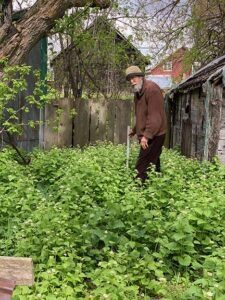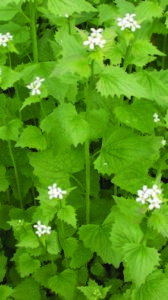Fred Schueler and Aleta Karstad, Fragile Inheritance Natural History
The official Ontario page sums up Alliaria petiolata pretty well: “Garlic Mustard is an invasive herb native to Europe. It was brought to North America in the early 1800s for use as an edible herb. Available in the early spring and high in vitamins A and C, it has a strong, distinctive smell similar to garlic. Since its arrival in North America, it has escaped into the wild and is now one of Ontario’s most aggressive forest invaders.” https://www.ontario.ca/page/garlic-mustard
Since the Galerucella biocontrol Beetles made Purple Loosestrife less conspicuous in the 1990s, Garlic Mustard has been one of the leading poster children for invasive species. One example of this is that for years the Ontario Biodiversity Education and Awareness Network promoted pulling Garlic Mustard as the central activity of its celebration of the International Day for Biological Diversity on May 22. In a hopeful launch of their Environmental History Project, the North Grenville Historical Society held a Garlic Mustard pull on May 22, 2017 in some sites in downtown Kemptville, followed by a picnic lunch, in which pulled Garlic Mustard was the main dish.
The first record of Garlic Mustard in Ontario was in Toronto, in 1879, and it was in Ottawa in 1891 and Kingston in 1898. We first recognized Garlic Mustard on May 8, 1994, in the urban residential valley of the Credit River at Port Credit, where we identified an “unrecognized herb on bare soil of steep slope” from the Peterson wildflower Field Guide. That summer we found it along the Lake Ontario waterfront, in 1995 on Petrie Island in the Ottawa River, in 1996 in a campground at Charleston Lake Provincial Park, and then in 1998 in Burritts Rapids and Kemptville, on the wooded slopes of the Rideau and of Kemptville Creek, near the central bridges of the settlements. In 2014, with a Nature Conservancy party, we saw it all through the wilderness woods of Cockburn Island, west of Manitoulin.
Garlic Mustard produces a variety of allelopathic chemicals which suppress the growth of other species, and of the mycorhizzal fungi that many forest plants depend on to transfer nutrients to their roots. The resulting solis stands have a two-year life cycle. In the first year the seedling grows a strong root system and a cluster of kidney-shaped leaves, and in the second it shoots up as high as a metre (though often only 25 cm) with soft toothed triangular leaves, and clusters of small white flowers, which mature into narrow pods of tiny black leaves. The 25 cm plants are slender pale green wands with a tiny cluster of flowers, while those that have fared better are a spreading cluster of stems, a metre high, unfolding many flowerheads, each unrolling a thicket of seed pods as it goes higher. Stands of the big plants are calculated to produce up to 105,000 seeds per square metre, and seeds can persist alive in the soil for 5 years.
We’re fighting against that productivity at our place in Bishops Mills. Before 2012, our scampering around to different habitats occasionally brought a few Garlic Mustard seeds home, and had one or two plants to pull in some years, until neighbours put in a septic tank mound, made of soil that seemed to be, as we said, “1.4% Garlic Mustard seeds by volume.” These spread across the fence onto our land, and in recent years our now-goatless Goat yard has been a solid stand of tall plants. Garlic Mustard is all around the yards and groves in solid stands and scattered plants, and even with constant surveillance, it’s going to be a decades-long project to beat it back, unless some biocontrol Weevils show up.


European root-chewing Weevils have been released in Ontario, but until they are established and have spread, control for household size populations is pulling every plant before it can set seed, and disposing of the pulled plants so that any seed they have set cannot mature and get away. This disposal need not be the bags-to-the-dump procedure outlined in some invasive species literature. A pile in the middle of a substantial stand will not spread seeds, and piles we have made have not germinated significant seedlings.
The chemicals that protect Garlic Mustard from competition and from many herbivores also make it strong and interestingly flavoured, and so part of control is getting to the plants while they are still tender, and converting them to human food.
If it’s just cooked as a potherb, with a bit of salt and oil, the garlic flavour can be somewhat overpowering if you just eat it straight. It works well, however, with anything sweet & sour, or smoky, tossed with cut-up boiled egg, bacon bits, and a starch such as rice, pasta shells or rotini. Every spring we fill a 5-gallon pail with chopped leaves & stems, with salt and red pepper, to ferment down into kim chii, which we use through the year as a source of flavour and saltiness in various dishes. It’s said that the seeds are also flavourful.
Last year’s wet fall, and this year’s long cool spring have been good for Garlic Mustard, and it has appeared around some homesites where it wasn’t present or conspicuous before. This is the first year Garlic Mustard has shown up at Michael Whittaker’s in Bishops Mills, and “they’ll be wacked, raked, dried in a plastic bag, and burned. The remainder will be pulled.”







“clusters of small white flowers, which mature into narrow pods of tiny black leaves.” is a lapsus for “clusters of small white flowers, which mature into narrow pods of tiny black seeds.”